| Title | Pages |
|---|---|
| Development and Validation of a Quantification Method for L-Dopa in Plants and Pharmaceutical Materials L-Dopa is an antiparkinsonian drug and is used per oral application. A reliable liquid chromatographic method for determination of L-Dopa in leaves, flowers and seeds of Vicia faba L. grown in Turkish habitats and pharmaceutical dosage forms has been developed. The analysis has been carried out using Ace C18 (5 μm, 4.6 x 250 mm,) column, and the separation was carried out using a mobile phase consisting of 50 mM potassium dihydrogen phosphate (pH 2.3) at a flow rate of 1.2 mL min-1 with UV detection at 280 nm. The method has been validated according to the acceptance criteria of the ICH guidelines. The method demonstrated good linearity (R2 > 0.999) over the assayed concentration range, good intra-day and inter-day precision. The detection limit (LOD) and the quantification limit (LOQ) values were determined as 1.70 and 5.13 μg mL-1 for L-Dopa. Developed method has been successfully used for the determination of L-Dopa in pharmaceutical formulations and plant materials. 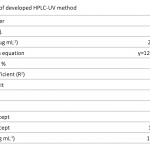
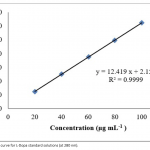
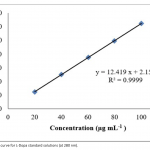
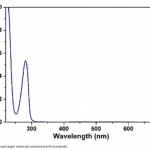
|
1 - 10 |
| Green Synthesis of Silver Nanoparticles from Phaseolus vulgaris L. Extracts and Investigation of their Antifungal Activities The aim of this study was to synthesize silver nanoparticles (AgNPs) using leaf, root, and stem extracts of Phaseolus vulgaris L. (Yunus-90) and elucidate their antifungal activities. In this regard, the prepared AgNPs have been characterized by using UV-vis, FT-IR, TEM, SEM, and DLS techniques. Then, the antifungal activity of both synthesized and commercially purchased AgNPs was investigated via (i) agar well diffusion, (ii) fungal colony morphotype diversity, (iii) inhibition of hyphae and (iv) minimum inhibition concentration (MIC) analyses against Colletotrichum sp., Fusarium oxysporum, Fusarium acuminatum, Fusarium tricinctum, Fusarium graminearum, Fusarium incarnatum, Rhizoctonia solani, Sclerotinia sclerotiorum, and Alternaria alternata. The AgNPs derived from the leaf extract displayed significantly higher levels of antifungal activity relative to the AgNPs prepared from the root and stem extracts. The commercial AgNPs also displayed lower antifungal activity than their green equivalents synthesized in this research, and even a low (~50 μg/mL) concentration of synthesized AgNPs was found to be effective in suppressing the growth of Fusarium tricinctum and Colletotrichum sp. 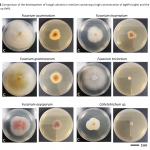
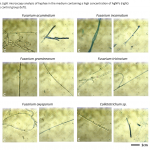
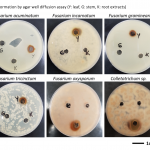
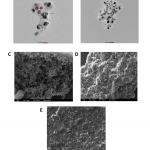
|
11 - 23 |
| In Vitro Evaluation Of Naproxen Metabolite, O-Desmethylnaproxen On A Mouse Connective Tissue Fibroblast Cells The aim of this in vitro study was assessment of the cytotoxic level of O-desmethylnaproxen. A mouse connective tissue fibroblast cell line, L929 was exposed to naproxen and O-desmethylnaproxen in different concentrations for 24- and 48- hours. Cell viability was tested by 3-[4,5-dimethylthiazol-2-yl]-2,5-diphnyltetrazolium bromide (MTT), while apoptosis was determined by acridine orange/propidium iodide (AO/PI) double staining method. The control group was free from any agent (Dulbecco’s Modified Eagle’s Medium (DMEM) only) and accepted as 100% cell viability. The IC50 results indicated that the inhibition of 50% cell viability was resulted by the highest concentration of O-desmethylnaproxen (0.7 μg/mL) while none of naproxen concentration was caused 50% cell death. Consequently, to avoid the unacceptable side effects of naproxen metabolites that evacuated by urine; further studies should be conducted to determine the accumulation of naproxen metabolites. 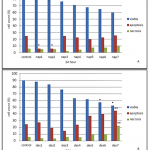
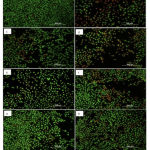
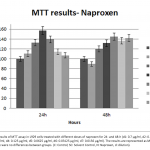
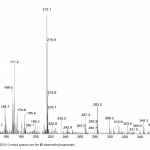
|
25 - 36 |
| Molecular Approach to Detecting Pollen Types In Honey: DNA Barcoding Nowadays, the demand for bee products has also increased due to the growing interest in natural products. Although it is quite easy to adulteration of honey, which is one of these products, it is also very difficult to detect adulteration. In the point of detecting forgery, studies are being carried out specifically to identify the plant sources of honey. Melissopalynological and chemical analyses are methods commonly used in order to identify the botanical origin of honey. Despite the fact that the detection of botanical origin of honey by DNA-based methods which provide faster, simpler and more reliable results are being carried out in recent years, these researches are very less in Turkey. Unlike morphological methods, which require the visual examination of pollen grains, the recently developed genetic methods have the potential to increase the resolution and scale of pollen analyses. In this study, the aim was to present cumulative data by compiling the results of the studies conducted using molecular techniques on honey, and the advantages and disadvantages of this technique were evaluated. |
37 - 41 |
| Terrestrial Vertebrate Fauna of Beytepe Campus, Hacettepe University Beytepe Campus (Hacettepe University) is one of the few isolated areas with large scale for wildlife within Ankara metropolis (Turkey). However, there is no checklist regarding to the terrestrial vertebrate (amphibian, reptile, avian and mammalian) fauna of this campus has ever been published so far. Therefore, field studies and literature surveys were conducted towards Beytepe Campus from 2005 to 2019. According to the results, a total of 3 amphibians, 11 reptilians, 93 avian and 14 mammalian species were identified in the study area. Due to increasing urbanization trends in this metropolitan city, this study will provide us a useful guide for further surveys and conservation activities in similar areas. 
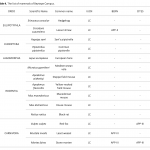
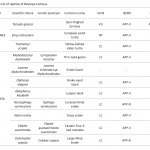

|
43 - 55 |
| Investigation of Biocatalytic Absorption and Ultrasound-Assisted Desorption Performance of CO2 Capture The CO2 absorption-desorption performance of non-aqueous solutions comprising a sterically hindered amine system (2-amino-2-ethyl-1,3-propanediol (AEPD): 1-hexanol) was investigated in a gas-liquid stirred cell reactor under sequential absorption-desorption cycles. The absorption capacity and initial absorption rate were calculated for different concentrations of AEPD: 1-hexanol at 303 K and 2 bar absolute pressure. Increasing the amount of AEPD increased the CO2 absorption capacity. The biocatalytic effect of a constant amount of carbonic anhydrase (CA) on the CO2 absorption performance was also investigated, and the CA enzyme was found to increase the total amount of absorbed CO2. The CO2 loading of AEPD: 1-hexanol and CA activated AEPD: 1-hexanol were 0.88 and 0.97 mol CO2/mol AEPD, respectively. CO2 desorption experiments were performed in different sequences of the same experimental set-up at 363 K and 1.1 bar absolute N2 pressure. The effect of ultrasonic irradiation on the desorption performance of 0.1 g/L CA catalyzed AEPD: 1-hexanol system was also investigated. It was observed that ultrasonic assistance shortened the desorption time and enhanced the desorption rate. Furthermore, the effectiveness of regeneration, the reusability, and performance loss of AEPD: 1-hexanol, in the presence and absence of CA, were analyzed by Fourier transform infrared spectrometry. 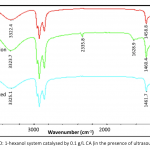
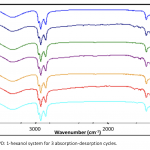


|
57 - 68 |
| The role of the Cellular Antioxidant Defense System on Oxidative Stress in Acute Appendicitis It is known that free radicals, their products and reactive oxygen species (ROS) are associated with many diseases. The study focuses on both some changes in oxidative stress factors in patients with acute appendicitis (AA) and the changes of glutathione S-transferase (GST) and paraoxonase-I (PON1) enzyme activities in the metabolism. This study involved control group (n = 31) and the study group (n = 52). In the groups, some changes in oxidative stress factors and GST and PON1 enzyme activities which play an important role in metabolism were determined. There are changes in GST activity between study and control groups. The activity of the enzyme were significantly higher in AA groups (p < 0.01) than control. Malondialdehyde (MDA) levels in acute perforated appendicitis (PeA) groups were found significantly higher than control (p <0.01). There is a negative correlation between mean platelet volume (MPV) and lipid peroxidation in AA patients (r=-0.654, p<0.01). An increase in GSH production and GST activity provides an important defense mechanism against the oxidation of some macromolecules and may prevent oxidative stress in patients with appendicitis to some extent. 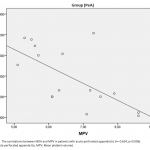
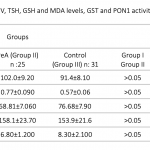
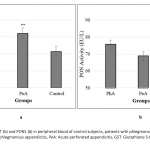
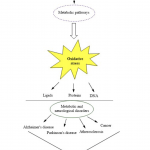
|
69 - 78 |
| Electrochemical Synthesis of Cauliflower-Like PtPd@PVF Nanocatalyst for Electrooxidation of Methanol In this study, a bimetallic catalyst consisting of Pt and Pd nanoparticles supported on poly(vinylferrocene), i.e., PtPd@PVF was electrochemically prepared on pencil graphite electrode to improve the catalytic properties of previously developed Pt@PVF catalyst. K2PtCl4 and K2PdCl4 were used as the metal precursors in order to disperse the Pt and Pd onto the conducting polymer support by cyclic voltammetry technique. Electrochemical and chemical reduction methods were compared for the reduction of Pt and Pd complexes. The prepared catalyst system was electrochemically characterized by cyclic voltammetry. Physical characterization of the catalyst was performed by recording scanning electron microscopy images and energy dispersive X-ray spectrum. The PtPd@PVF catalyst showed superior catalytic activity towards electrooxidation of methanol compared to the monometallic Pt/PVF catalyst. 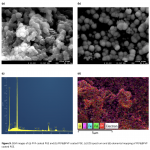
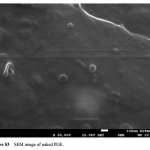
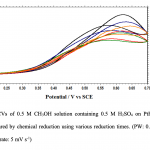
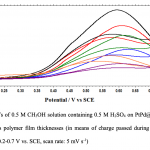
|
79 - 91 |
| Synthesis and Characterization of P (N-Isopropylacrylamide) Hydrogels with Tunable Swelling Behavior Using Different Crosslinkers In the present study, a set of hydrogels were synthesized using N-isopropylacrylamide with various cross linkers at various dosages via free radical polymerization. Thermal and structural properties of the synthesized hydrogels were characterized via thermogravimetric analyzer (TGA) and Fourier Transformation Infrared Radiation (FTIR) spectroscopy. The effect of crosslinkers such as N,N ́-Methylenebisacrylamide, ethylene glycol dimethacrylate (EGDMA) polyethylene glycol dimethacrylate (p(EGDMA), and polyethylene glycol diacrylate (p(EGDA) (Mn: 258, Mn: 575, Mn: 700) were used in p(NIPAM) hydrogel preparation and their effect on swelling behavior was investigated. It was found that the swelling rate was increased as the molecular masses of the cross-linkers used decreased, whereas the hydrogel prepared using p(EGDA)-700 swelled more than the other p(EGDA) crosslinked p(NIPAM) hydrogels. 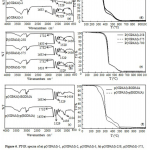
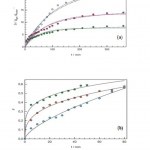
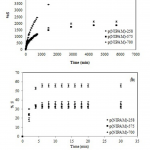

|
93 - 106 |
| DNA/HSA Interactions and Anticancer Activity of a Palladium(II) Saccharinate Complex Bearing Ethyldiphenylphosphine The binding interactions of cis-[Pd(sac)2(PPh2Et)2] with DNA and HSA were comprehensively studied by a number of experimental methods and molecular docking studies. The Pd(II) complex bound to AT-rich sites in the major groove of DNA, and interacted with the hydrophobic cavity of the subdomain IIA of HSA. These experimental findings were supported by molecular docking studies. The Pd(II) complex had shown strong cytotoxic activity against different cancer cell lines and it also had selectivity especially for MCF-7 breast cancer cells higher than cisplatin. 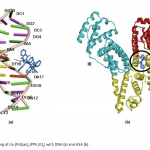
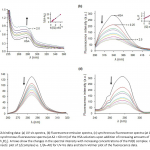

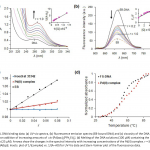
|
107 - 116 |